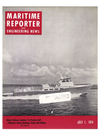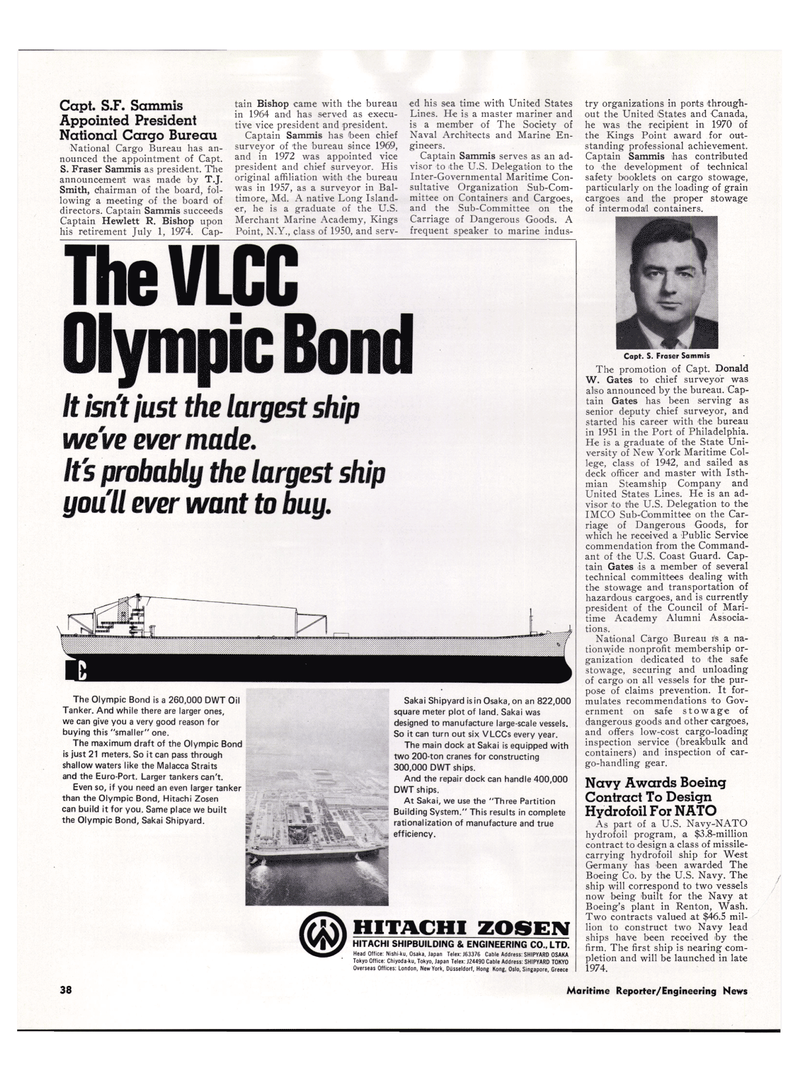
Page 31: of Maritime Reporter Magazine (July 1974)
Read this page in Pdf, Flash or Html5 edition of July 1974 Maritime Reporter Magazine
Capt. S.F. Sammis
Appointed President
National Cargo Bureau
National Cargo Bureau has an- nounced the appointment of Capt.
S. Fraser Sammis as president. The announcement was made by T.J.
Smith, chairman of the board, fol- lowing a meeting of the board of directors. Captain Sammis succeeds
Captain Hewlett R. Bishop upon his retirement July 1, 1974. Cap- tain Bishop came with the bureau in 1964 and has served as execu- tive vice president and president.
Captain Sammis has been chief surveyor of 'the bureau since 1969, and in 1972 was appointed vice president and chief surveyor. His original affiliation with the bureau was in 1957, as a surveyor in Bal- timore, Md. A native Long Island- er, he is a graduate of the U.S.
Merchant Marine Academy, Kings
Point, N.Y., class of 1950, and serv- ed his sea time with United States
Lines. He is a master mariner and is a member of The Society of
Naval Architects and Marine En- gineers.
Captain Sammis serves as an ad- visor to the U.S. Delegation to the
Inter-Governmental Maritime Con- sultative Organization Sub-Com- mittee on Containers and Cargoes, and the Sub-Committee on the
Carriage of Dangerous Goods. A frequent speaker to marine indus- try organizations in ports through- out the United States and Canada, he was the recipient in 1970 of the Kings Point award for out- standing professional achievement.
Captain Sammis has contributed to the development of technical safety booklets on cargo stowage, particularly on the loading of grain cargoes and the proper stowage of intermoda'l containers.
Capt. S. Fraser Sammis
The promotion of Capt. Donald
W. Gates to chief surveyor was also announced by the bureau. Cap- tain Gates has been serving as senior deputy chief surveyor, and started his career with the bureau in 1951 in the Port of Philadelphia.
He is a graduate of the State Uni- versity of New York Maritime Col- lege, class of 1942, and sailed as deck officer and master with Isth- mian Steamship Company and
United States Lines. He is an ad- visor to the U.S. Delegation to the
IMCO Sub-Committee on the Car- riage of Dangerous Goods, for which he received a Public Service commendation from the Command- ant of the U.S. Coast Guard. Cap- tain Gates is a member of several technical committees dealing with the stowage and transportation of hazardous cargoes, and is currently president of the Council of Mari- time Academy Alumni Associa- tions.
National Cargo Bureau i's a na- tionwide nonprofit membership or- ganization dedicated to the safe stowage, securing and unloading of cargo on all vessels for the pur- pose of claims prevention. It for- mulates recommendations to Gov- ernment on safe stowage of dangerous goods and other cargoes, and offers low-co(st cargo-loading inspection service (breakbulk and containers) and inspection of car- go-handling gear.
Navy Awards Boeing
Contract To Design
Hydrofoil For NATO
As part of a U.S. Navy-NATO hydrofoil program, a $3.8-million contract to design a class of missile- carrying hydrofoil ship for West
Germany has been awarded The
Boeing Co. by the U.S. Navy. The ship will correspond to two vessels now being built for the Navy at
Boeing's plant in Renton, Wash.
Two contracts valued .at $46.5 mil- lion to construct two Navy lead ships have been received by the firm. The first ship is nearing com- pletion and will be launched in late 1974.
IheVLCC Olympic Bond
It isn't just the largest ship we've ever made.
It's probably the largest ship you'll ever want to buy.
The Olympic Bond is a 260,000 DWT Oil
Tanker. And while there are larger ones, we can give you a very good reason for buying this "smaller" one.
The maximum draft of the Olympic Bond is just 21 meters. So it can pass through shallow waters like the Malacca Straits and the Euro-Port. Larger tankers can't.
Even so, if you need an even larger tanker than the Olympic Bond, Hitachi Zosen can build it for you. Same place we built the Olympic Bond, Sakai Shipyard.
Sakai Shipyard is in Osaka, on an 822,000 square meter plot of land. Sakai was designed to manufacture large-scale vessels.
So it can turn out six VLCCs every year.
The main dock at Sakai is equipped with two 200-ton cranes for constructing 300,000 DWT ships.
And the repair dock can handle 400,000
DWT ships.
At Sakai, we use the "Three Partition
Building System." This results in complete rationalization of manufacture and true efficiency.
HITACHI ZOSE1V
HITACHI SHIPBUILDING & ENGINEERING CO., LTD.
Head Office: Nishi-ku, Osaka, Japan Telex: J63376 Cable Address: SHIPYARD OSAKA
Tokyo Office: Chiyoda-ku, Tokyo, Japan Telex: J24490 Cable Address: SHIPYARD TOKYO
Overseas Offices: London, New York, Diisseldorf, Hong Kong, Oslo, Singapore, Greece 10
Maritime Reporter/Engineering News

 30
30

 32
32
